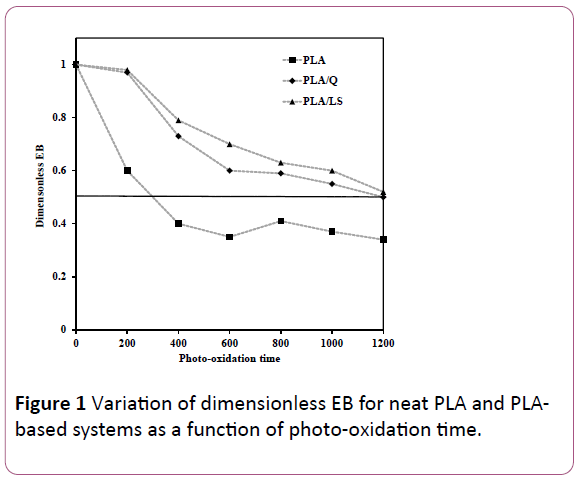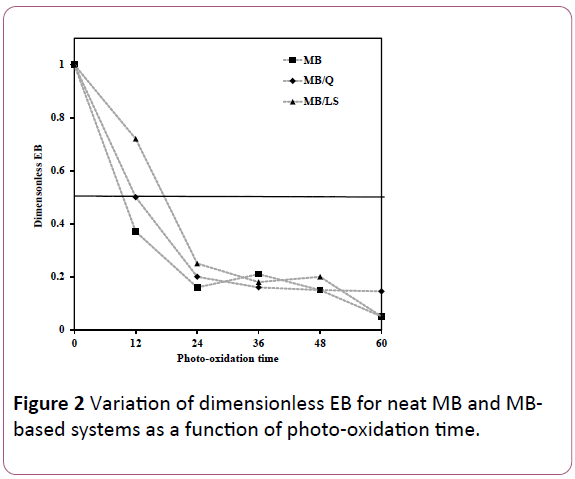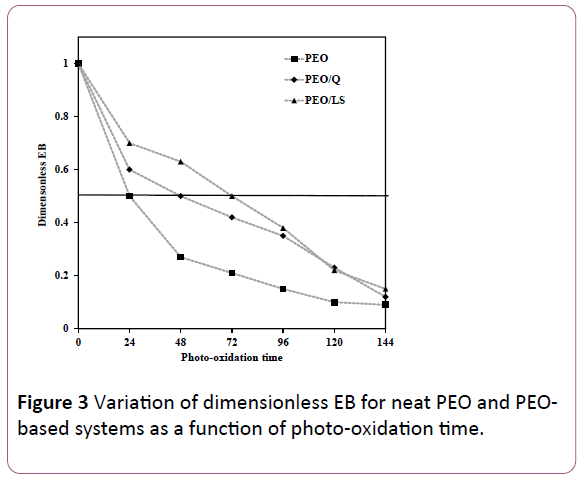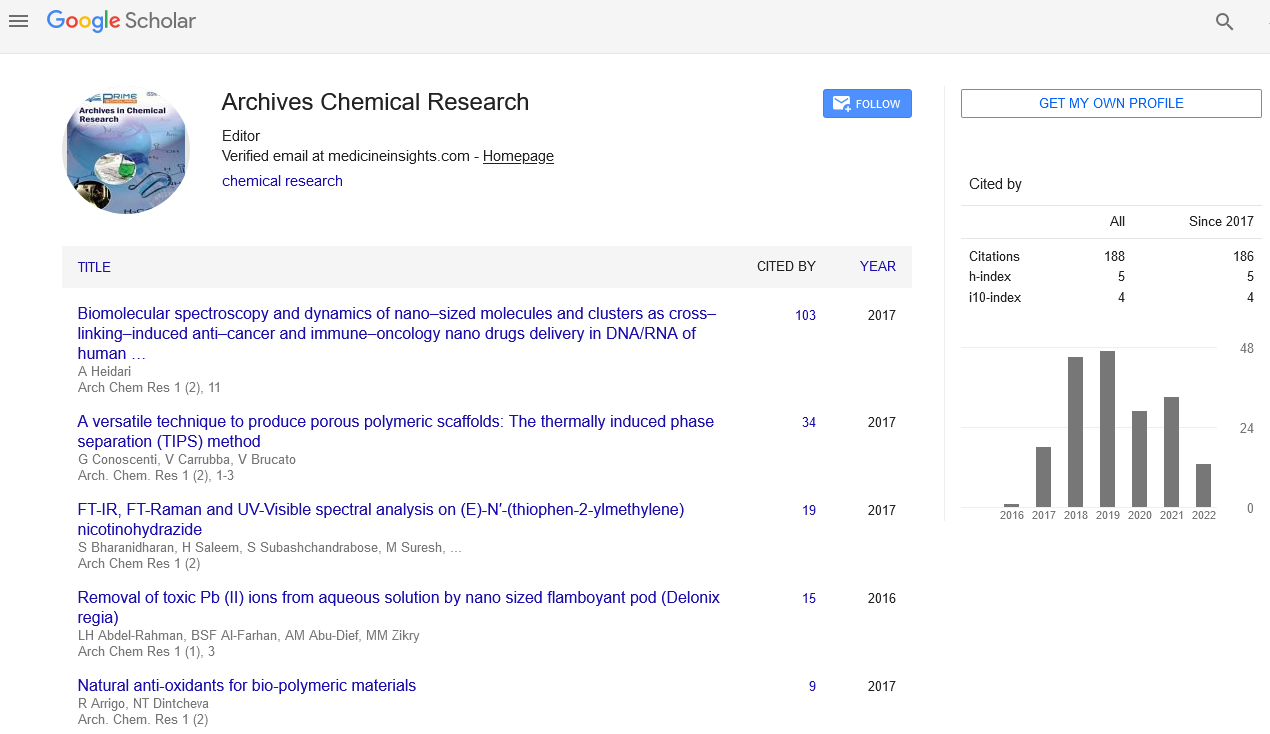Keywords
Anti-oxidants; Polymer; Starch
Introduction
Biodegradable polymers have been widely investigated to
replace synthetic polymers, because of environmental concerns
and decreasing availability of fossil resources [1]. The potential
use of biodegradable polymers in the agricultural field as
covering films or mulching films, and in biomedical applications
is a very promising and challenging issue. However, the products
formulated using biodegradable polymers must show
properties, performances and durability comparable to those of
the products formulated using conventional fossil fuel-based
polymers [2]. In particular, the maintenance of the performance
during their lifetime is a critical topic for successful applications.
Indeed, the thermo- and photo-oxidative degradation of
polymers and polymer-based systems is a key issue for these
class of materials [3]. Usually, the protection against thermoand
photo-oxidative degradation is realized through the adding
of suitable stabilizing systems, such as anti-oxidants, light
stabilizers, thermal stabilizers, and fire retardants [4].
The specific applications of bio-polymers require the use of
naturally occurring additives, which are able to enhance the
resistance during processing, at typical processing conditions, or
during lifetime, in presence of high temperature or UV light. So,
in the recent years researchers have focused a growing attention to formulations based on bio-polymer and natural stabilizing
agent [5]. Several natural compounds with different chemical
nature may be considered as stabilizers in polymers, and
specifically in bio-polyesters [6,7]. The use of natural compounds
as anti-oxidants in polymers and bio-polymers, provides similar
stabilizing action to that of synthetic anti-oxidants; additionally,
they have low toxicity as many natural anti-oxidants are typical
compounds used to protect human health. The potential of
flavonoids, a class of natural polyphenols, as anti-oxidants and
UV light stabilizers for polyolefins has been recently investigated
by Samper et al. [8]. The effectiveness of used phenolic
compounds as thermal stabilizers at high temperature has been
probed.
Quercetin is an abundant flavonoid suitable in stabilizing
polymer against both thermo-oxidation during processing, and
photo-oxidation during UV exposure. Its protective action is
performed by reducing free radical formation, scavenging free
radicals and, also, binding transition metal ions [9]. It is of
fundamental importance to investigate and to verify the
usefulness of flavonoids in the thermo- and photo-oxidation
stabilization also for bio-polymers. The protection of
biodegradable polymer provided by flavonoid compound is to be
similar to that obtained using synthetic commercial light
stabilizer.
Polylactic acid PLA is a compostable thermoplastic made from
renewable sources and able to degrade into innocuous lactic
acid. PLA is used as medical implants and for the encapsulation
of many therapeutic agents due to its high hydrophobicity,
strong mechanical strength and slow drug release [7]. PLA,
furthermore, can be used as a compostable packaging material.
The maintenance of the performance during its lifetime,
however, remains a critical point for successful application.
Mater-Bi® is completely biodegradable and compostable biopolymer,
made using natural and synthetic raw materials that
does not involve the exploitation of virgin or deforested lands.
Mater-Bi® is a recent bio-polymer that has, already, applications
in the manufacture of film for agricultural mulching,
biodegradable cotton buds, toys and bioplastic carrier bags [10].
Poly(ethylene oxide) PEO is an attractive biomaterial because
of biocompatibility, hydrophilicity, and versatility. It is used in
novel drug delivery systems and it finds potentially use in
technological applications as solid electrolytes in electrochemical devices such as batteries [11]. Premature
degradation, that occurs due to aliphatic ethers, is a tricky issue
for the use of PEO and the use of stabilizing systems is
absolutely required.
In this study the stabilization provided for biodegradable films
by natural compounds was evaluated and compared to those
provided by a commercial synthetic light stabilizer. The obtained
results show that quercetin is suitable for the protection against
photo-oxidation of bio-polymer matrices. Therefore bio-polymer
films containing natural stabilizing molecules are excellent
candidates for outdoor application and as smart and
environmental-friendly packaging, where the release of
bioactive compounds during lifetime of the packaging can
improve food stability.
Experimental Part
Materials
The materials used in this work were:
• Polylactic acid PLA 2002D (PLA) supplied by Natureworks
(USA);
• Mater-Bi® CF04P (MB), undisclosed composition, kindly
supplied by Novamont spa (Italy);
• Polyethylene oxide (PEO) supplied by Sigma-Aldrich (USA);
• Quercetin hydrate, natural flavonoid compound (Q), supplied
by Sigma-Aldrich srl. Molecular weight: 302.24 g/mol;
Formula: C15H10O7 xH2O; Purity: >= 95%;
• Cyasorb® THT® 6460, synthetic heterocyclic Light Stabilizers
(LS) – (1,6-Hexanediamine, N,N’-bis(2,2,6,6-tetramethyl-4-
piperidinyl)-, polymers with morpholine-2,4,6-
trichloro-1,3,5-triazine reaction products, methylated and
formaldehyde) kindly supplied by Cytec spa.
Formulation of polymer-based films
Both natural (quercetin) and synthetic (light stabilizer)
stabilizing compounds have been added to the bio-polymers
films at 0.5 wt% before the processing.
The PLA films were obtained using a single screw extruder
equipped with a film head and equipped with a calender unit.
The temperature profile was 210-210-200-200°C and the screw
speed was 60 rpm. The film thickness was about 100 microns for
all the samples.
The Mater-Bi® films were obtained using a single screw
extruder equipped with a film blowing head and with a
Brabender film blowing unit. The temperature profile was
90-120-130-145°C and the screw speed was 80 rpm. The film
thickness was about 50 microns for all the samples.
The PEO films were obtained using a a Brabender mixer at
T=90°C at a mixing speed 50 rpm for 5 min. The films, with a
thickness of about 100 microns, were obtained by compression
molding.
Characterization
The accelerate weathering was performed on unstabilized film
and stabilized films using a Q-UV (U.S.A.) chamber, containing
eight UVB-313 (Q-Labs Corp., U.S.A) lamps. The exposure cycle
conditions were: 8 h of light at T=55°C followed by 4 h
condensation at T=35°C. The measured photon flux was 2
mW/cm2.
Mechanical tests were carried out, at room temperature and
humidity, using an Instron (U.S.A.) dynamometer mod. 3365,
according to ASTM test method D882 (crosshead speed of 100
mm/min).
Statistical analysis of the data was performed through ANOVA
by using the GraphPad Prism version 6 software (GraphPad
Software Inc., La Jolla, CA, USA). Significant differences among
mean values, where applicable, were determined by the means
of ANOVA and by Tukey’s HSD post hoc test for multiple
comparisons. In all cases, a value of p<0.05 was considered
statistically significant [7].
Results and Discussion
In Table 1, the main mechanical properties, i.e. the elastic
modulus, E, tensile strength, TS and elongation at break, EB, of
unstabilized films (PLA, MB and PEO) and all stabilized films
before the photo-oxidative treatment are reported.
| Sample |
E, MPa |
TS, MPa |
EB,% |
| PLA |
1556 ± 52a |
47.1 ± 2.5a |
9.3 ± 1.5a |
| PLA/Q |
1684 ± 56b |
44.8 ± 2.2a |
14.8 ± 2.0b |
| PLA/LS |
1843 ± 62c |
51.2 ± 2.5b |
19.5 ± 2.5c |
| MB |
105 ± 5a |
24.2 ± 1.2a |
435 ± 22a |
| MB/Q |
119 ± 6b |
27.0 ± 1.3b |
470 ± 24b |
| MB/LS |
120 ± 6b |
24.6 ± 1.2a |
440 ± 22a |
| PEO |
60.5 ± 2.3a |
3.5 ± 0.3a |
105 ± 5.0a |
| PEO/Q |
55.2 ± 2.5b |
3.1 ± 0.2b |
110 ± 6.0a |
| PEO/LS |
54.2 ± 2.3b |
3.2 ± 0.3a,b |
115 ± 7.5b |
Table 1: Main mechanical properties, i.e. the elastic modulus, E,
tensile strength, TS and elongation at break, EB, of unstabilized
and stabilized films before the photo-oxidation (Values are given
as means ± SD. Different letters in the same column, for each
investigated system, indicate significant differences (p<0.05)
when analyzed by Tukey’s multiple comparisons tests)
As far as the PLA- and MB-based systems is concerned, the
addition of both natural and synthetic stabilizers leads to an
increase of the Elastic Modulus and of the properties at break.
The slight increase of the EB for all PLA- and MB-based systems
can be attributed to some plasticizing effect caused by the
stabilizing molecules; indeed, it is known that the low molecular weight molecules dispersed in polymer matrices are able to
increase the free volume of the system, reducing the friction
between the macromolecules. The rises of both E and TS values
of the stabilized systems to the respect of those of neat matrices
clearly suggest an increased rigidity of the stabilized films in the
machine direction. This issue can be attributed to the higher
orientation of the macromolecules achieved during the drawing
in presence of a plasticizing agent. The increased orientation
improves the rigidity of these samples and this effect overcomes
the plasticizing action.
Concerning the PEO-based systems, the addition of stabilizing
molecules causes a decrease of the E values and an increase of
the properties at break. The obtained results can be explained
considering the plasticizing action exerted by the stabilizing
molecules, which leads to the obtainment of a more ductile
material. In contrast to the PLA- and MB-based systems, the
formulations based on PEO have not been subjected to drawing
during processing, thus no preferential macromolecules
orientation was achieved and the only observable effect is that
due to the plasticizing action of added molecules.
Let us to discuss about the photo-oxidative behavior of
investigated samples. According to the literature, the
mechanism of PLA photo-oxidative degradation involves
hydrogen abstraction on the polymer backbone, leading to the
formation of macroradicals that, reacting with oxygen, form
peroxy radicals and hydroperoxides [12]. The last decompose
with the formation of alkoxy radicals that, in turn, degrade
through three different β-scission reactions, leading mainly to
the generation of anhydrides. Moreover, hydrolytic degradation
of PLA needs to be taken into account; the hydrolytic chains
cleavage occurs mainly in the bulk of the material and not only
on its surface and proceeds preferentially in the amorphous
regions, leading to the formation of carboxylic acid end groups.
The photo-oxidative behavior of MB is a very complex issue,
given that this polymer matrix is a multi-component system and
hence a large amount of radicals coming from different
components needs to be taken into account, along with the
possible reactions/interactions between them [13].
Concerning PEO, the first step of its oxidative pathway is the
hydrogen abstraction on the polymer backbone by a free radical,
with the formation of a macroradical that, reacting with oxygen,
gives a peroxy radical that evolves in a hydroperoxide. The
photochemical decomposition of this hydroperoxide leads to the
formation of an alkoxy radical that can evolve following three
routes: (1) -scission, leading to the formation of formate end
groups; (2) cage reaction with HO which gives ester functions
formation; (3) hydrogen abstraction reaction with formation of a
hemiacetal that, in turn, decomposes to form alcohols and
carboxylic acids [11]. Therefore, the main oxidation products of
PEO formed upon UVB irradiation are essentially formats, esters,
carboxylic acids, and alcohols.
The chemical modifications of polymeric materials which
occur during the photo-oxidation process due to the
degradation reactions, are detrimental for the mechanical
properties of the materials. In particular, all the chemical
modifications result in a severe embrittlement of the material. For this reason, the progress of the degradative process can be
followed by analysing the variation of the polymer mechanical
properties as a function of the photo-oxidation time. In Figures
1-3, the dimensionless Elongation at break of all investigated
systems based on PLA, MB and PEO as a function of the
exposure time are reported. All dimensionless values have been
calculated by dividing the values of EB at a given exposure time
by the value measured before the photo-oxidation. The EB is the
mechanical property more sensitive to all morphological and
structural changes occurring during photo-oxidation process.
The dashed lines in the Figures 1-3 indicates the time at 50%, i.e.
the time at which the EB value is one half of the initial one
(0.5EB). The time at 50% can be considered as the maximum
time at which a film can be used; after this time severe
mechanical damages occur. For all investigated bio-polymersbased
systems, a beneficial effect can be noted by adding the
quercetin, especially at short exposure times. Otherwise, for
long exposure times, the values of the dimensionless EB for
unstabilized and stabilized systems are very similar. It is
noteworthy that the three investigated bio-polymers show
different photo-oxidation behavior due to the different chemical
nature and different absorption ability in the UV-B range. The
photo-oxidation of PLA is a slow process: after about 1200 h of
exposure, the value of its dimensionless EB is slightly lower than
the 0.5EB value. MB and PEO, instead, show faster photooxidation
and the values of dimensionless EB reach the 0.5EB
values after 12 h and 24 h, respectively. To sum up, all obtained
results indicate that quercetin molecules are able to protect all
the investigated bio-polymers in a similar way to what observed
for commercial synthetic light stabilizer.
Figure 1: Variation of dimensionless EB for neat PLA and PLA based systems as a function of photo-oxidation time.
Figure 2: Variation of dimensionless EB for neat MB and MB based systems as a function of photo-oxidation time.
Figure 3: Variation of dimensionless EB for neat PEO and PEO based systems as a function of photo-oxidation time.
Conclusions
Biopolymers-based films containing a natural phenolic
compounds have been formulated and their photo-oxidation
behaviour has been investigated and compared to that of
systems containing a synthetic commercial light stabilizer. All
obtained results indicate that Quercetin is able to offer a
remarkable stabilizing action against the photo-oxidative
degradation of polymeric materials. In all, obtained results open
new perspectives in the use of natural compounds as ecofriendly
stabilizers, to get fully bio-based polymer systems with
enhanced photo-oxidative stability.
References
- Lim LT, Auras R, Rubino M (2008) Processing technologies for poly(lactic acid). ProgrPolymSci 33: 820-852.
- Dintcheva NT, Al-Malaika S, Morici E, Arrigo R (2017) Thermo-oxidative stabilization of polylactic acid-based nanocomposites through the incorporation of clay with in-built antioxidant activity. J ApplPolymSci 134: 44974.
- Kumar AP, Depan D, Tomer NS, Singh RP (2009) Nanoscale particles for polymer degradation and stabilization—Trends and future perspectives. ProgrPolymSci 34: 479-515.
- Al-Malaika S (1997) Reactive Modifiers for Polymers, Blackie, Academic and Professional, an imprint of Chapman and Hall, London, ISBN 0-7514 0265 6.
- Agustin-Salazar S, Gamez-Meza N, Medina-Juàrez LA, Soto-Valdez H, Cerruti P (2014) From Nutraceutics to Materials: Effect of Resveratrol on the Stability of Polylactide. ACS SustChemEng 2: 1534-1542.
- Arrigo R, Dintcheva NT, Guenzi M, Gambarotti C, Filippone G, et al. (2015) Thermo-oxidative resistant nanocomposites containing novel hybrid-nanoparticles based on natural polyphenol and carbon nanotubes. PolymDegr Stab 115: 129-137.
- Arrigo R, Morici E, Dintcheva NT (2016) Biopolyester-based systems containing naturally occurring compounds with enhanced thermo-oxidative stability. J ApplBiomaterFunct Mater 14: 455-462.
- Samper MD, Fages E, Fenollar O, Boronat T, Balart R (2013) The potential of flavonoids as natural antioxidants and UV light stabilizers for polypropylene. J ApplPolymSci 129: 1707-1716.
- Arrigo R, Dintcheva NT, Guenzi M, Gambarotti C (2016) Nano-hybrids based on Quercetin and Carbon Nanotubes with excellent antioxidant Activity. Mater Lett 180: 7-10.
- Cerruti P, Santagata G, Gomez d’Ayala G, Ambrogi V, Carfagna C, et al. (2011) Effect of a natural polyphenolic extract on the properties of a biodegradable starch-based polymer. PolymDegr Stab 96: 839-846.
- Arrigo R, Ruisi G, Teresi R, Dintcheva NT (2016) Effect of nanodiamonds on structure and durability of Polyethylene oxide-based nanocomposites. J Nanomater 2016: 5436823.
- Gardette M, Therias S, Gardette JL, Murariu M, Dubois P (2011) Photooxidation of polylactide/calcium sulphate composites. PolymDegrad Stab 96: 616-23.
- Dintcheva NT, La Mantia FP, Arrigo R (2014) Natural compounds as light stabilizer for a starch-based biodegradable polymer. J PolymEng 34: 441-449.




